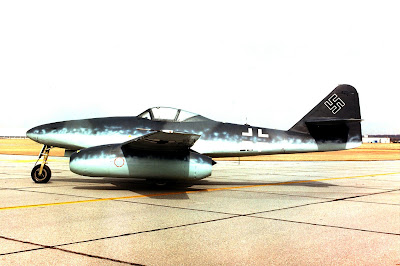DAYTON, Ohio -- Messerschmitt Me 262A at the National Museum of the United States Air Force. (U.S. Air Force photo)
www.nationalmuseum.af.mil is provided as a public service by the National Museum of the United States Air Force, Public Affairs.
Information presented on www.nationalmuseum.af.mil is considered public information and may be distributed or copied. Use of appropriate byline/photo/image credits is requested.
This file is a work of an employee of the U.S. Armed Forces, taken or made during the course of the person's official duties. As a work of the U.S. federal government, the file is in the public domain.
Generally speaking, works created by U.S. Government employees are not eligible for copyright protection in the United States. See Circular 1 "COPYRIGHT BASICS" PDF from the U.S. Copyright Office.
Developed from a 1938 design by the Messerschmitt company, the Me 262 Schwalbe was the world's first operational turbojet aircraft. First flown under jet power on July 18, 1942, it proved much faster than conventional airplanes. Development problems (particularly its temperamental engines), Allied bombings and cautious Luftwaffe leadership contributed to delays in quantity production.
On July 25, 1944, an Me 262 became the first jet airplane used in combat when it attacked a British photo-reconnaissance Mosquito flying over Munich. As a fighter, the German jet scored heavily against Allied bomber formations. U.S. Army Air Forces bombers, however, destroyed hundreds of Me 262s on the ground. Of the more than 1,400 Me 262s produced, fewer than 300 saw combat. Most Me 262s did not make it to operational units because of the destruction of Germany's surface transportation system. Many of those that did were unable to fly because of lack of fuel, spare parts or trained pilots.
The Me 262A on display was brought to the United States from Germany in July 1945 for flight evaluation. Restored by the 96th Mobile Maintenance Squadron, Kelly Air Force Base, Texas, in 1976-1979, it is painted without operational unit markings as an aircraft that has just left the production line.














No comments:
Post a Comment